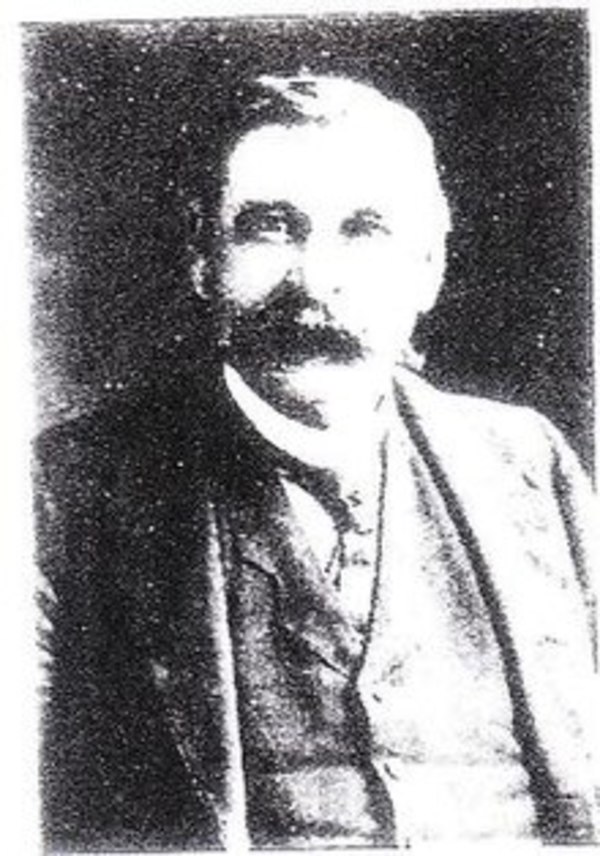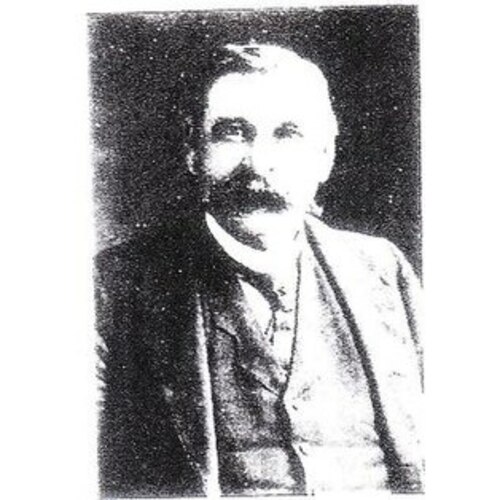
Source: Courtesy of Wikimedia Commons
CHAMBERLAIN, THEODORE F., doctor, politician, businessman, and civil servant; b. 6 July 1838 in Smith’s Mills (Harlem), Upper Canada, son of Dr Asher (Ashern) Augustus (Augustine) Chamberlain and Eliza Ann Toffy; m. 3 July 1862 Annetta Jane Parish in Farmersville (Athens), Upper Canada, and they had five children, of whom a son and a daughter survived infancy; d. 5 March 1927 in Chaffey’s Lock, Ont.
The son of American parents who had settled as children in Leeds County, Upper Canada, Theodore Chamberlain received his early education at the local school in Bastard Township, supplemented by sabbath schools and lessons in Latin at home. In 1853, after two years as a merchant’s clerk in nearby Elgin, he studied dentistry in Ottawa. He then practised in the Leeds area, Pawling, N.Y. (his mother’s birthplace), and New York City, but returned to Canada in 1858 at his father’s behest to pursue a medical degree at Queen’s College in Kingston. He graduated in 1862 and hung his shingle in Morrisburg, on the St Lawrence River. Although he styled himself a “physician, surgeon and accouchear,” he was, like many 19th-century doctors, a medical jack of all trades, running a drugstore (1866–73), teaching medical students, and acting as Morrisburg’s officer of health, coroner for the United Counties of Stormont, Dundas and Glengarry (1868–79), and a consulting physician for life insurance companies.
As Chamberlain’s practice prospered, he threw himself into municipal politics, becoming village councillor (1873–77, 1884–86), reeve (1877–81), and counties warden (1879–80). Additional to this activity was his superintendence of the local school board, a commission in the Leeds militia, a directorship in the Dundas Agricultural Association, and membership in the Methodist Church, masonic lodges, and temperance organizations. In provincial politics, he followed in the footsteps of his father, a Baldwinite reformer “of the old school.” In 1879 he accepted the nomination of the Reform convention of Dundas as its candidate for the Legislative Assembly. Defeated by 81 votes, he ran federally in 1882 but again lost by a narrow margin.
These rejections, though disappointing, allowed Chamberlain to devote time to his expanding business interests, where family connections proved important. In 1873 he sold his drugstore and established the first of three cheese factories in partnership with his brother-in-law W. G. Parish. In the 1870s and 1880s he travelled a great deal, with frequent trips to the United States, but it was northern Ontario that captured his enduring interest. Many summers were spent hunting, prospecting, and surveying around Lake Superior, Georgian Bay, and Lake Nipissing. The Parry Sound and Muskoka districts, which Chamberlain visited as a tourist in search of the sublime and the untamed, also provided economic opportunities. He received “a handsome competence” from the sale of timber rights in 1872 and in 1877 he became a director of the Parry Sound Lumber Company, owned by another brother-in-law, Liberal mla John Classon Miller*. In 1888 Chamberlain Township in the northerly Timiskaming district would be named in his honour.
The provincial contest of December 1886 proved a turning point in Chamberlain’s political fortunes. Elected for Dundas, he kept a low profile as a new member of the government of Oliver Mowat*, voting with the majority, serving on the standing committees for railways and municipalities, and introducing a housekeeping amendment of the Municipal Act. His legislative career was cut short after only one session, when his return was contested and the ensuing by-election, in January 1888, was carried by James Pliny Whitney*. He was not forgotten by the Liberals, however. In 1890 he was named to fill the vacancy in the provincial inspectorate of asylums, prisons, and public charities (hospitals, refuges, and orphanages) caused by the death of Dr William T. O’Reilly. Chamberlain, who turned over his medical practice in Morrisburg to his son, Watson Parish, and began work as inspector of prisons and charities in October, inherited a system created largely by John Woodburn Langmuir*. His 14-year tenure was characterized less by innovation than by the growth of the system. For instance, the number of hospitals receiving grants for the care of indigent patients under the Charity Aid Act ballooned from 16 to 61. Chamberlain’s glowing, often platitudinous, reports satisfied his political masters, and helped the province sustain its boast that its system was second to none. Behind the reports, as his correspondence reveals, was an inspector who, committed to centralization, involved himself in the affairs of individual patients, oversaw every institutional expenditure (no matter how trivial), and held to a punishing schedule of inspectorial trips. In 1893 he displayed his detailed knowledge in a pamphlet aimed at resolving sectarian misunderstandings about the funding of Roman Catholic and Protestant charities.
Official satisfaction with the hospitals was not unexpected – most were new and Chamberlain’s relationships with their administrators were cordial. As for the provincially funded prisons, concerns were occasionally raised about classification, recidivism, and rehabilitation, but few hard questions were asked so long as they continued to generate profits through work programs. The 51 county jails and lock-ups were of a different order. Most had been constructed in the Upper Canadian period, and Chamberlain was highly critical of their condition. Twice-annual inspections – usually by Chamberlain, often unannounced – were invariably followed by demands to county councils that rotting cells be repaired, kerosene lighting replaced with electricity, and connections made to municipal sewage systems. In 1892 he even ordered the jailer at Mattawa to mow the lawn. Changes were slow in coming, but, overall, material conditions in the jails improved significantly on Chamberlain’s watch. Of greater concern was the use to which they were put. Throughout the 1890s over a quarter of all inmates were lunatics, paupers, and others committed under the Vagrants Act. A dismayed Chamberlain pointed in 1891 to the impossibility of properly classifying prisoners in such an environment, which he characterized as “inhuman, unchristian and unpatriotic.” Although grants were available for erecting poorhouses, parsimonious local officials preferred the cheaper, more expedient solution of housing the destitute in the jails. Chamberlain eroded these savings by instructing that paupers be supplied with civilian clothing and improved diets. It was not long before he was threatening to use the courts to force county councils to construct proper accommodations. His greatest triumph came in 1903 when legislation required each county to erect a poorhouse by 1906.
Chamberlain did not remain in office to see the full fruition of his crusade. Leaving in 1904 to contest the federal election in Dundas, he was defeated after a “hot fight,” but in 1906, at age 67, he secured another patronage plum: federal health inspector of public works. Between June 1906 and his resignation in March 1908, he monitored conditions in railway construction camps in the four western provinces, sleeping in tents and frequently travelling on foot as he enforced compliance with the Public Works Health Act. In 1909 he was hired by the Department of Indian Affairs to value the timber on the Dokis Indian Reserve near Lake Nipissing [see Migisi*]. When rights were auctioned in June 1909 – to benefit the band – Chamberlain himself paid $182,000 for a berth, which he logged to great profit.
His government service at an end, the indefatigable Chamberlain returned to Morrisburg, where he again worked as a physician, dispensed veterinary medicine, and, until 1919, ran a sanatorium out of his large residence. Widowed in July 1924, he died of pneumonia at his retirement cottage at Chaffey’s Lock in 1927 and was buried in the family plot in Athens.
Theodore F. Chamberlain is the author of Aid to Protestant and Catholic hospitals: official statement by the inspector of hospitals and charities for Ontario; falsehoods exploded; the truth regarding the matter ([Toronto, 1893]).
AO, F 1023; F 1941-18, vol.2; RG 22-179, no.8234; RG 55-1, liber 7: f.6; RG 63-A-10; RG 80-8-0-950, no.4383; RG 80-8-0-1066, no.19808; RG 80-27-2, 28: 63. LAC, RG 38, A-2, 418: 1127-30. Athens Reporter and County of Leeds Advertiser (Athens, Ont.), 10 March 1927. Canadian Illustrated News (Montreal), 2 March 1878. Dundas County Herald (Morrisburg, Ont.), 27 March 1879, 1 Jan. 1880. Dundas Courier (Morrisburg), 11 Jan. 1867. Evening Recorder (Brockville, Ont.), 14 Oct. 1904. Morrisburg Courier, 18 Dec. 1867, 29 April 1870. Ottawa Citizen, 23 July 1909. Recorder and Times (Brockville), 11 July 1924, 9 March 1927. Can., Parl., Sessional papers, reports of the Dept. of Agriculture, 1906/7-10. J. S. Carter, The story of Dundas, being a history of the county of Dundas from 1784 to 1904 (Iroquois, Ont., 1905). Cyclopædia of Canadian biog. (Rose and Charlesworth), vols.1 and 3. J. G. Harkness, Stormont, Dundas and Glengarry; a history, 1784–1945 (Oshawa, Ont., 1946). T. W. H. Leavitt, History of Leeds and Grenville, Ontario, from 1749 to 1879 . . . (Brockville, 1879; repr. Belleville, Ont., 1972). Ont., Legislature, Journals, 1887: 20; Sessional papers, 1873, no.11; 1874, no.39; reports of the inspector of asylums, prisons, and public charities, 1890–1905.
Cite This Article
Patrick J. Connor, “CHAMBERLAIN, THEODORE F.,” in Dictionary of Canadian Biography, vol. 15, University of Toronto/Université Laval, 2003–, accessed April 25, 2025, https://www.biographi.ca/en/bio/chamberlain_theodore_f_15E.html.
The citation above shows the format for footnotes and endnotes according to the Chicago manual of style (16th edition). Information to be used in other citation formats:
| Permalink: | https://www.biographi.ca/en/bio/chamberlain_theodore_f_15E.html |
| Author of Article: | Patrick J. Connor |
| Title of Article: | CHAMBERLAIN, THEODORE F. |
| Publication Name: | Dictionary of Canadian Biography, vol. 15 |
| Publisher: | University of Toronto/Université Laval |
| Year of revision: | 2005 |
| Access Date: | April 25, 2025 |



